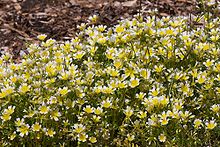
The Magnoliaceae are a flowering plant family, the magnolia family, in the order Magnoliales. It consists of two genera: Magnolia and Liriodendron.
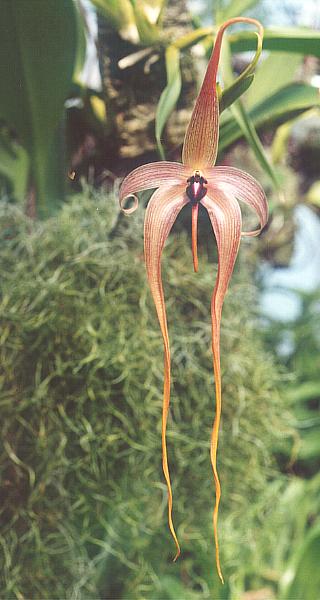
Bulbophyllum is a genus of mostly epiphytic and lithophytic orchids in the family Orchidaceae. It is the largest genus in the orchid family and one of the largest genera of flowering plants with more than 2,000 species, exceeded in number only by Astragalus. These orchids are found in diverse habitats throughout most of the warmer parts of the world including Africa, southern Asia, Latin America, the West Indies, and various islands in the Indian and Pacific Oceans. Orchids in this genus have thread-like or fibrous roots that creep over the surface of trees or rocks or hang from branches. The stem is divided into a rhizome and a pseudobulb, a feature that distinguished this genus from Dendrobium. There is usually only a single leaf at the top of the pseudobulb and from one to many flowers are arranged along an unbranched flowering stem that arises from the base of the pseudobulb. Several attempts have been made to separate Bulbophyllum into smaller genera, but most have not been accepted by the World Checklist of Selected Plant Families.
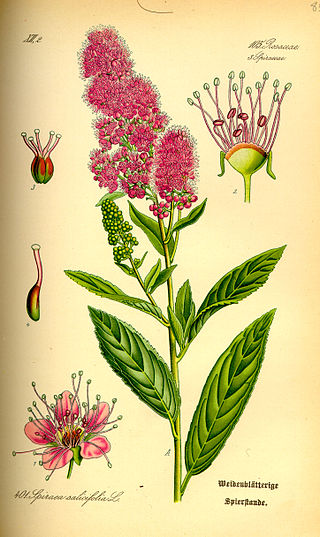
Spiraea, sometimes spelled spirea in common names, and commonly known as meadowsweets or steeplebushes, is a genus of about 80 to 100 species of shrubs in the family Rosaceae. They are native to the temperate Northern Hemisphere, with the greatest diversity in eastern Asia.

Limnanthes douglasii is a species of annual flowering plant in the family Limnanthaceae (meadowfoam) commonly known as Douglas' meadowfoam or poached egg plant. It is native to California and Oregon, where it grows in wet, grassy habitat, such as vernal pools and spring meadows. It can grow in poorly drained clay soils. The plant was collected by the Scottish explorer and botanist David Douglas, who worked on the west coast of America in the 1820s.

The scarlet gourds are a genus with 25 species. It is distributed in sub-Saharan Africa and with one species, C. grandis also in South Asia and Southeast Asia, and it is also introduced into the New World. Incidentally, C. grandis is also a cultivated crop and it is used for culinary and medical purposes.
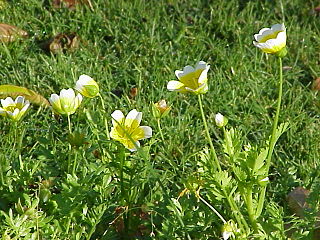
The Limnanthaceae are a small family of annual herbs occurring throughout temperate North America. There are eight species and nineteen taxa currently recognized. Members of this family are prominent in vernal pool communities of California. Some taxa have been domesticated for use as an oil seed crop. Some members are listed as threatened or endangered and have been the focus of disputes over development plans
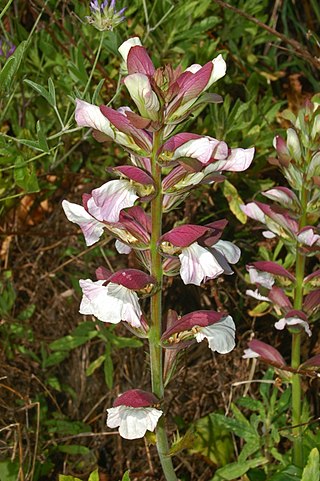
Acanthus mollis, commonly known as bear's breeches, sea dock, bear's foot plant, sea holly, gator plant or oyster plant, is a species of plant in the family Acanthaceae and is native to the Mediterranean region. It is a leafy, clump-forming perennial herb, with a rosette of relatively large, lobed or toothed leaves, and purplish and white flowers on an erect spike.

Limnanthes alba is a species of flowering plant in the meadowfoam family known by the common name white meadowfoam. It is native to California and Oregon, where it grows in wet grassy habitat, such as vernal pools and moist spots in woodlands. It generally grows in poorly drained soils. It is an annual herb producing an erect or decumbent stem up to about 30 centimeters long. The leaves divided into several lobed or unlobed leaflets. The flower is cup-shaped with white petals 1 to 1.5 centimeters long.
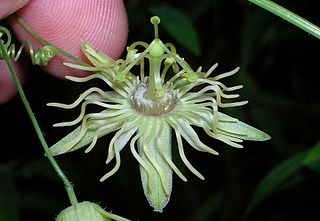
Passiflora lutea, commonly known as yellow passionflower, is a flowering perennial vine in the family Passifloraceae, native to the central and eastern United States. The vine has three-lobed leaves and small, yellowish-green, fringed flowers that appear in the summer, followed by green fruit that turn almost black at maturity. It grows in moist to wet habitats.

Limnanthes vinculans, the Sebastopol meadowfoam, is an endangered species of meadowfoam found only in the Laguna de Santa Rosa in Sonoma County, California, United States and an area slightly to the south in the Americano Creek and Washoe Creek watersheds. The name vinculans derives from the Latin root vinculum, meaning "a bond, a cord." The specific epithet vinculans means linking or bonding, in reference to the sharing of some characters of L. vinculans with L. douglasii (R.Br) and L. bakeri.

Platystemon is a monotypic genus of flowering plants in the poppy family containing the single species Platystemon californicus, which is known by the common name creamcups. It is native to Oregon, California, Arizona, Utah and Baja California, and is found in open grasslands and sandy soils below 6,000 feet (1,800 m) elevation.

Ixerba brexioides, the sole species in the genus Ixerba, is a bushy tree with thick, narrow, serrated, dark green leaves and panicles of white flowers with a green heart. The fruit is a green capsule that splits open to reveal the black seeds partly covered with a fleshy scarlet aril against the white inside of the fruit. Ixerba is an endemic of the northern half of the North Island of New Zealand. Common names used in New Zealand are tawari for the tree and whakou when in flower. It is assigned to the family Strasburgeriaceae.

Rhynchospora alba, the white beak-sedge, is a plant in the sedge family, Cyperaceae. It is a tufted herbaceous perennial around 50 cm tall, with white inflorescences that flower in August. The fruit of the sedge is a small achene with a characteristic beak-like cap. It is dispersed by wind or falls by gravity, leading to individuals existing in tight clumps. The species favours wet, acidic and nutrient poor soils, thriving in Sphagnum-dominated bogs, but also peaty grasslands. As such it is often used as a positive indicator for bog and mire ecosystem health.
Blennosperma bakeri is a rare species of flowering plant in the daisy family known by the common names Baker's stickyseed and Sonoma sunshine.

Limnanthes floccosa, or woolly meadowfoam, is a species of meadowfoam found in Northern California and Southern Oregon, in the United States. Most of the subspecies have highly restricted distributions and are listed as critical or endangered.
Limnanthes montana is a species of meadowfoam known by the common name mountain meadowfoam. It is endemic to the Sierra Nevada foothills of California, where it grows in wet, grassy habitat such as marshy spring meadows.
Limnanthes striata was formerly a species of meadowfoam known by the common name foothill meadowfoam. It has recently been subsumed into the species Limnanthes douglasii in both the Jepson Manual and the Flora of North America. This plant is endemic to California, where it is known from the Sierra Nevada foothills and the southern Klamath Mountains. It grows in wet, grassy habitat, carpeting the edges of vernal pools and ephemeral creeks.
Pedicularis howellii is an uncommon species of flowering plant in the family Orobanchaceae known by the common name Howell's lousewort. It is endemic to the Siskiyou Mountains of the Klamath Range in southern Oregon and northern California, where it grows on the edges of coniferous forests. This is a perennial herb producing one or more stems up to 45 centimetres (18 in) tall from a long caudex. The leaves are up to 20 centimetres (8 in) long, lance-shaped, and divided into many toothed oval lobes; those higher on the stem may be unlobed. The basal leaves fall away early. The inflorescence is a small raceme of flowers occupying the top of the stem. Each white to light purple flower is up to one centimetre long and is sickle-shaped, with a curved beak-like upper lip and a three-lobed lower lip which may be tucked into the hairy mass of sepals. The plant is pollinated by bumblebees including Bombus mixtus. Between the flowers are hairy to woolly triangular bracts. The fruit is a capsule just under a centimeter long containing seeds with netted surfaces.
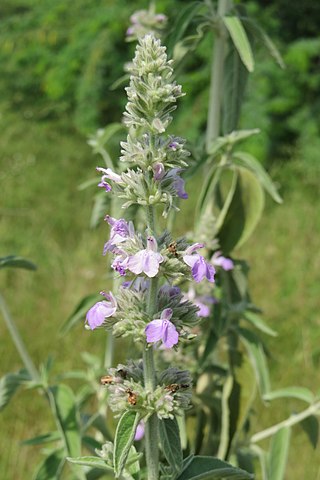
Anisomeles malabarica, more commonly known as the Malabar catmint, is a species of herbaceous shrub in the family Lamiaceae. It is native to tropical and subtropical regions of India, and Sri Lanka, but can also be found in Malaysia, Bangladesh, Myanmar, Bismarck Archipelago, Mauritius, Andaman Islands and Réunion.
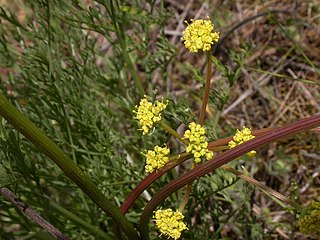
Lomatium cookii is a rare species of flowering plant in the carrot family known by the common names Cook's lomatium and agate desertparsley. It is endemic to Oregon in the United States, where it grows in only two valleys. It is a federally listed endangered species.
